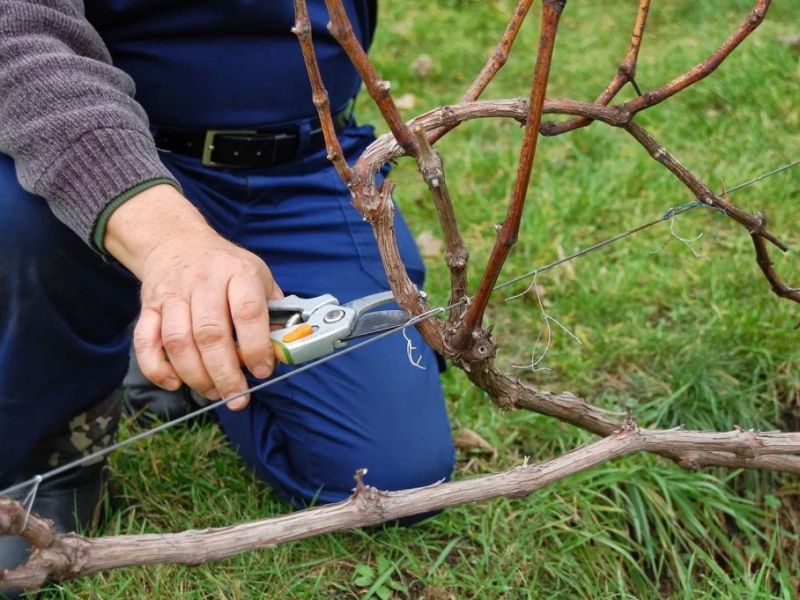
Grapes - a universal culture, with its variety of varieties and species, it can yield crops even in cold climates with a short summer, however, if improperly maintained, it will disappoint even in the warmest and sunniest regions. One of the most important measures for the formation of a healthy, actively fruiting bush is pruning.
One of the most common methods is spring treatment immediately after waking up. By observing simple rules and choosing the right technique, you can avoid thickening of the vine, other typical problems such as peeling and even freezing.
Content
Why pruning is important in spring
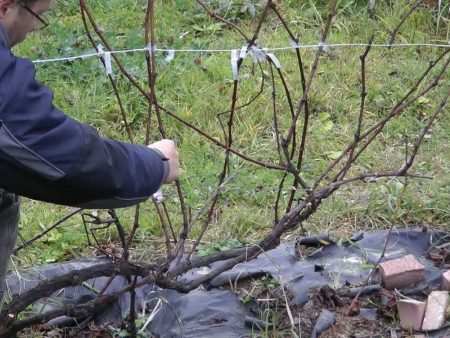
All grape varieties are classified as strong and bushy, medium and weak, but all of them equally need pruning. Since this plant is a fruiting vine, it is necessary to help him direct his efforts to growing either greenery if the planting is decorative, or berries if the goal is to get a rich harvest.
Some modern varieties are created specifically to combine these two characteristics: with lush decorative greenery they give a good harvest, however, they are more likely technical varieties with low scores for taste.
Pruning in any season is important because it allows you to:
- reduce thickening, improve lighting;
- get rid of diseased shoots, branches and leaves;
- increase the level and quality of pollination.
Processing can be carried out not only in spring, but also in autumn, however, the first option is the most common, because it has a number of advantages. Firstly, it is spring manipulations that can increase productivity already in the current season by 60-80 percent. This happens due to the direction of all the forces of the plant to the formation of berries, due to better access of the sun to the berries, it is also important that a larger percentage of flower stalks are pollinated.
Secondly, during this period, it is possible to form the parameters of the bush itself. This is both its width and height. Excessive growth will not allow you to fully harvest, pruning will help even the largest bush to be successfully distributed in the area allocated to it.
The third advantage is increased frost resistance. After waking up, the grapes almost immediately lays future fruiting shoots, however, frosts can occur more than once before the summer temperature is established. Pruning will be hardened, as it makes the bush more hardy and stable.
The fourth reason to prune in the spring is the ability to remove all parts of the plant damaged by the cold, not to harm the bush even with the wrong actions. Pruning requires accuracy: it is necessary to remove the maximum of extra leaves and stepsons, but at the same time leave branches, vines that can give the greatest yield. If mistakes were made during processing in the fall, grapes have time to recover, after wintering, the results may disappoint. Over the summer, on the contrary, recovery occurs if the errors were not critical.
There is one significant drawback with spring pruning methods: the risk of completely ruining the grapes by too late pruning. When the illumination and temperature reach a certain level, sap flow begins. After processing, liquid will stand out from all sections, the bush “Crying”, as culture lovers call it.In this case, saving the plant is extremely difficult and in most cases it dies within one or two seasons.
Sap flow rarely begins in March and most often occurs in April in most regions of the country. The plant "focuses" on the temperature of the soil, not air. Once it reaches 6 degrees, grapes can begin to move juices and nourish the vines.
How to crop correctly
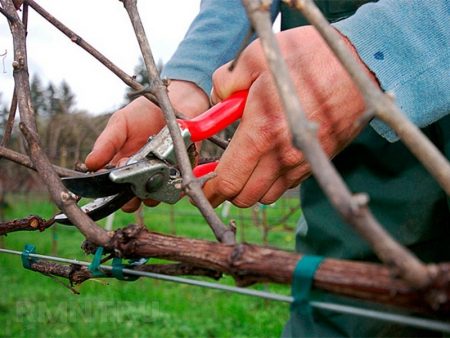
Regardless of the trimming method chosen, with or without the formation of the stem, several basic rules must be followed. All branches are processed only on one side and with an exceptionally sharp secateurs. So, you can avoid damage to the rest of the bush. It is necessary to find an eye on the shoot to determine the direction of the cut, the line should be directed from it, and not vice versa. It is important to understand what a fruit arrow and a knot of substitution are: the first should be higher than the second.
Selecting the branches to be deleted is simple. First of all, these are all frozen, sick, with a changed color, suspicious heels, attacked by bugs. Secondly, these are all too thin and too thick branches. The former will not produce fruit due to too strong growth of greenery, while the latter are unlikely to withstand a bunch of a sufficiently large size. All that is larger than 12 mm and less than 4 mm in diameter must be removed.
Stamping
Pit bushes give the best yields in the southern climate and in the middle zone. For hot and sunny summers with a length of 150-170 days, the so-called “clean” mushrooms are suitable, for a shorter vegetative period, cordons that do not rise too high above the ground.
Such pruning should begin in the first year of landing. It is necessary to leave only 2 eyes, which look the most powerful and healthy. During the summer they will give and grow two shoots, they should be covered for wintering, since it is in the first year that the risk of grape death is greatest.
In the second year, the formation of the stem begins. The strongest shoot needs to be cut into 3 kidneys, the weaker one by 2. The main shoot should be tied to a vertical support, the reserve should be taken a little to the side. In the future, you can translate the support in a horizontal plane to form a regular bush. Pinch all buds below the branches to leave a clean stump.
The third year must begin by pinching all the eyes on the stem, as they will certainly appear again. On each shoot, 2 strong shoots should form, leave them, cut out the rest. The optimal size is 2 kidneys. Only one branch should be left in the reserve shoot.
The formation of a spare bush is necessary, because in a few years it is these shoots that will allow you to rejuvenate the bush after cutting the entire main stem.
Dieless molding
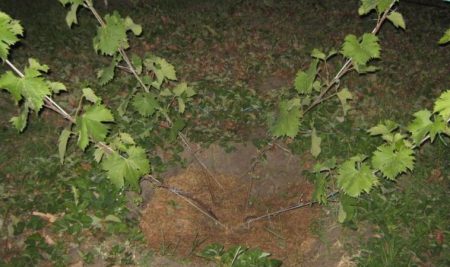
In the first year, it is enough to rid the grapes of only diseased branches and young shoots. Be sure to prepare the grapes cut in the spring in the fall for wintering: in a warm climate, sprinkle the base with soil, in a cold climate - completely cover it.
Next year you can leave from 2 to 6 shoots, depending on the number of strong and developed branches. Moreover, the size of the space that is reserved for a particular bush should be taken into account, since a fruit-bearing sleeve will be formed from each shoot. Cut the vine into 4 buds, make 2 of them “blind”, form the strong and clean shoots from the remaining two.
In the third and all other years, the main task is the selection of fertile links of optimal length. On the vine, leave 2 buds each. After that, it is also necessary to form two shoots, each of which is tied up vertically. Thus, the branches branch. Work is always carried out with the lowest formations. This principle is then used in cultivation, because after 4 years the grapes are considered already formed. Rejuvenation will be needed after 6-8 years.
Arched trimming
Arched grapes not only look unusual, it also takes up a minimum of free space on the site, can be planted over functional areas. At the same time, proper pruning and proper care allows you to get a crop on such an arch even more than on a flat trellis.
Arched bushes belong to the standard, so in the early years, pruning is similar to that already described, however, you need to leave only one shoot until it reaches its support, for example, a wire, at the planned height. Constant renewal of the arch without excessive growth is achieved by replacing the vines. This can only be done in the fall, so spring pruning is more optional for this type of bushes. When processing before the start of the growing season, the main task will be to form sleeves in an amount up to 6. These are optimal sizes for arches.
Arched bushes feel great in any climate except extremely cold, where full shelter for the winter is required.
Emergency pruning: how to tidy a bush
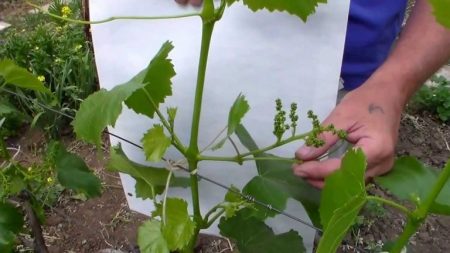
It is not always possible to cut bushes in time in spring. Often, new owners have to put in order bushes that have not previously been trimmed correctly. In addition, the processing is able to rid the grapes of diseases and affect the final indicators of the crop, even if the problems are already obvious.
Not always neglected bushes do not give a crop, most often they bear fruit even in this state, however, this does not mean that they do not require care. Grapes, which gives the crop in any quantities, are pruned annually. The processing of fruiting stands should consist, first of all, in the removal of excess buds in the spring, the optimal amount is 2 or 4 units. In addition, it is necessary to regularly cut all infected vines, all poorly wintering. You can’t leave them in the hope of awakening next season. This will only reduce yields.
Damaged bushes also need to be cut only at rest, so as not to injure them even more. It is possible to determine that the vine has already died and will no longer bear fruit, using control cuts, they are made at three points at an equal distance. If the cut is dry and light, then you can remove the shoot. Particular attention should be paid to pruning the youngest stepchildren, they take away the juices and strength from the entire bush, which will be required to restore existing damage. It is impossible to leave the grapes uncut if there are any “injuries”; in the future, the condition of the bush will only worsen.
Cold Challenge: Pruning Frozen Bushes
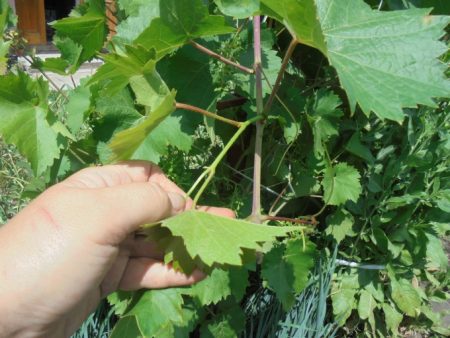
Even well-sheltered grapes can be damaged by severe frosts. This happens especially often in those winters, when the snow cover is too thin, there is not enough natural protection of the soil. The main blow falls on the kidneys and eyes.
Grapes have one feature that is not very pleasant for the owners: they are actively frightened by vines and shoots afraid of the cold, while substitutive, reserve ones often endure even the most severe winters.
Frozen vines
On frozen bushes of grapes do not produce mass pruning and pinching. In such a year, one cannot count on a plentiful harvest; it is important to preserve the plant. First of all, it is necessary to determine which vines were preserved, and secondly, which buds remained alive. To do this, make control sections and see what is the color of the internal structure, whether the juice passes through these branches. Spring pruning should be done after estimating the amount of losses.
If less than 60 percent of the kidneys were injured, the rest survived, the treatment should have a standard volume, however, the dead parts should be removed, and then, based on the shape obtained, then plan the pruning. If frost killed more than 80 percent of the eyes, annual vines suffered, changes began in the cortex of the main trunk, two stages of treatment must be planned.All new shoots are pruned, strong and viable vines are pruned briefly for further formation of the sleeves, leaving literally 2-4 eyes. After that, after a few weeks, the remaining green shoots are cut. Completely dead branches can be left on a support until the fall, it is not necessary to remove them in the spring, especially if this can damage the living green part.
Some plantation owners use root restoration technology when the ground part freezes completely. They dig out the living part about 30 centimeters from the ground, then wait for the shoots to appear, pruning is carried out only next year according to one of the standard schemes.
Frozen roots
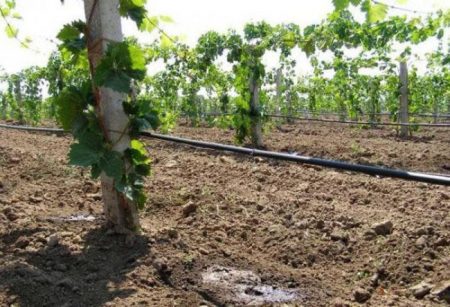
Freezing the roots is a dangerous phenomenon. If they died more than 70 percent, it makes no sense to try to restore the bush, it is better to uproot it and plant a new one. It is important for the active restoration of grapes in the spring to feed the root system with nitrogen fertilizers.
To improve the condition of living roots, abundant watering should be done with warm water with a temperature of 40 to 50 degrees. In the spring, you should cover the ground under the bush with a black geo-fabric, it will help warm the soil.
Determining the state of the roots is very simple: you need to dig a hole half a meter from the main shoot, preferably at several points. If the roots are brown or black, they are not viable. If white, then they did not suffer.
Unexpected frost
Freezing in May and even in June, sharp nighttime cooling - all this is not uncommon even in the southern regions. If the grapes have been damaged, do not immediately cut the shoots completely. You can cut them into two-thirds so that new ones can develop in the future. This will not affect crop yields too significantly, however, in this way valuable varieties and young bushes can be preserved.
If the main sleeves and vines are severely damaged as a result of unexpected temperature changes, they should not be removed immediately completely, however, it is necessary to limit the pruning of reserve branches.
Grapes after hail
Hail can cause serious damage to the vineyard at any time of the year. Before pruning, it is better to treat with antifungal drugs. You need to do this even if the first berries have already begun to appear. Vines and shoots are pruned according to the same principle as in the case of sudden spring frosts. The most damaged and weakest branches are cut out, the rest are shortened for possible recovery.
What to do after trimming
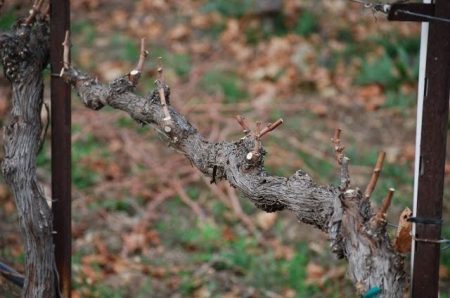
Proper care after pruning will further increase yield or even correct processing errors. Slices should be immediately treated with paste. It is suitable in the case when the juice flows actively to stop the process, and for the prevention of infection with fungal diseases. Immediately after pruning, signs of oidium may appear, especially in bushes without resistance to the disease. Milk treatment will help: it is diluted in a proportion of 1:10 with slightly warm water.
In order for the bushes to “open”, actively form after pruning, and generally go into the growth stage as early as possible, it is necessary to take care of fertilizer. Ammonium sulfate and superphosphates are suitable for this purpose.
Simple watering in the ground is ineffective for grapes. Fertilizers should be laid to a depth of 30-40 centimeters.
Reviews
Vitaliy: in the last 7 years he has completely switched to the arched method of cultivating grapes and is very pleased. He designed the track on the site, and even the recreation area and children's games. I like that the clusters literally hang down separately from the leaves, the collection has been greatly simplified. The crop is amazing. Every year I pour water with a solution of ash immediately after trimming, there have never been any diseases on the plant.
Yuri: We plant grapes in our Amur Region, we always choose frost-resistant varieties and form a standard; we have better winters. In recent years, we always shelter with two-layer geofabric; there has never been freezing.If the grapes wake up for a long time, I pour them with warm water and immediately begin pruning until the juices go.
Grape pruning is a must in any climate and for any variety. A heat-loving plant requires a maximum of light, excellent ventilation of the soil, which can be achieved only by eliminating the thickening. Spring pruning is an alternative to autumn processing, especially if you have a difficult and long wintering.

 Non-covering winter-hardy grape varieties for Moscow region
Non-covering winter-hardy grape varieties for Moscow region How to keep the vine in winter
How to keep the vine in winter When can I transfer grapes to another place in the fall
When can I transfer grapes to another place in the fall How to cover and prepare grapes for the winter in the suburbs
How to cover and prepare grapes for the winter in the suburbs